Text
Divination with Dice:
Dice by: crystalmaggie on esty

Astragalomancy, also known as astragyromancy, is a form of divination that uses dice specially marked with letters or numbers.
Much like the playing card, dice or dice like objects were used by multiple oppressed groups throughout history! They were ways for those oppressed by the church to keep their tradtions and beliefs in secret.
This divination practice has been around for centuries the oldest dice like set we know right now are from ancient Persia from the area of modern Iran and they are approximately 5000 years old.
We'll start with and their meanings in the way that I was taught. So mind you, this is simply the way I was taught their meanings.
So well go all the way up to 20:
1. No
2. Yes
3. No, be wary
4. self-expression and self-fulfillment.
5. Only if you are careful.
6. Don´t be afraid to take chances.
7. inner wisdom, self-awareness, intuition and mysticism.
8. Eternity and inner steadiness.
9. Enlightenment or answers will come.
10. Spiritual enlightenment and spiritual awakening.
11. Insight and understanding
12. Growth.
13. Death and change.
14. Reassurance from your guardians.
15. Wisdom and manifestation.
16. New beginnings and renewal.
17. Good fortune and a complete victory.
18. Breaking free of what binds you and encouragement.
19. The beginning and the end, aka you're most likely very much screwed.
20. Confidence, determination, optimism, and positivity.
You can also use even and odds for simple yes and no.
Odds = No
Even = Yes
1K notes
·
View notes
Text
"Apollo is just a uwu soft sunshine boy!"
Apollo, the God who guarantees freedom?
Apollo, bringer of disease as well as health?
Apollo, who without his light, all life would cease to exist?
Apollo, God of the heatwaves, blinding lights, the chemical compounds that birthed and maintain a star you can't even look upon without hurting yourself?
Apollo, God of music and poetry, raw emotion made physical through melodies and words sewn together, compositions and words that remain timeless?
That Apollo?
682 notes
·
View notes
Text
american folk magic rant
for everyone who keeps insisting on sending me shitty messages:
IT’S 2018 AND I STILL HAVE TO SAY THIS, JFC
Hoodoo, Appalachian folk magic, and powwow/braucherei (Pennsylvania Dutch folk magic) are NOT all the same. They may share similarities, but that does not at all make them the same practice. So stop conflating them, you damn heathens. I’m sick of researching and finding literature that says they’re all the same thing, or that credits one for creating the others. It’s some shit.
Hoodoo (also known as conjure, rootwork, etc) is a African-American folk magic practice that originated in Africa that was born of combining the traditions of the slaves with some herbal knowledge of the Native Americans. Over time, thanks to syncretism, rootwork incorporated elements of European grimoire traditions and Jewish mysticism. While it uses a lot of Biblical material (the use of the Psalms comes to mind), it is not inherently religious.
Appalachian folk magic is an amalgamation of Scots-Irish traditions brought with the immigrants that came to the region in the 1700s, Cherokee influence, and a hearty helping of Protestantism (though, it’s often in a pretty animist way).
Braucherei blends elements of European folk religion and healing charms, brought to colonial Pennsylvania by the German speaking immigrants. While a majority of the Pennsylvania Dutch people were Protestant, a lot of the folk religious culture was based in pre-Reformation practices. That belief system was brought over by the German immigrants and influenced the rituals and practices in the tradition. It was also heavily influenced by the sheer number of religious groups in the region, thanks to Penn’s religious tolerance. (Admittedly, I’m not a practitioner of this path. If you’re interested in learning more about it, I recommend you talk to my friend, @all-knowledge-is-powerful, who is pretty cool and more knowledgeable than I about the topic)
Naturally, as time goes on and people migrate and talk and grow, paths blend. You might find that your tradition surprisingly incorporates certain elements of another, and that happens. It’s cool! Things are meant to be shared. Plenty of folk magic paths and traditions resemble each other. Many of them have the same general concept going on: work with what you’ve got. It’s easy to see how they all blend together so well.
But, for the love of all that is holy, please stop saying they’re all the same thing. Doing that not only pains me, it also separates these paths from their historical context and some really cool history. By separating these paths from their history, it makes it kind of difficult to see why certain things are the way they are and why/how certain elements of the practice came to be. Essentially, by mashing them all together under one big mess, you lose the subtle nuances that make these practices so rich and interesting. Taking the time to learn about and celebrate their origins can be a really informative and empowering experience for you and your magic!
3K notes
·
View notes
Text
ways to practice magic in everyday life

incorporate knot magic into your knitted/crocheted/sewn projects. I find projects like this very meditative. I often imbue meaning into garments I create as I work on them (willing them to keep me warm on cold nights, or to protect me when I wear them out)
use herbs that correspond to your needs and intentions. this also applies to teas. many teas and herbs have multiple purposes- do your research! I really enjoy kitchen witchery personally. you can also build an herb or tea garden of plants you use regularly in your practice, to connect even further.
incorporate devotional acts into your everyday life, if you worship any deities. many things like cleaning your home, going for walks, taking a hot bath, etc can also be devotional acts to certain deities.
build routines. savoring a cup of tea or coffee in the morning, sitting on your porch and listening to nature, meditating, stretching in the morning/at night, doing a daily tarot pull, and so on. mindfulness is its own type of little magic, in my eyes.
journal, write letters, and so on. I find writing to both be therapeutic as well as a great way to connect with my deities and my craft. you can write letters to yourself, to your deities, to other people. journal every day as a form of meditation. set aside some time in the day to add to your grimoire, if you have one.
use color and scent correspondences in your wardrobe, perfumes, etc. look up correspondences to give you an extra layer of protection or an extra boost of confidence on days where you feel you need them.
there are plenty of other things than these, but these were the few things I could think that I often do off the top of my head. look for the magic in the little things. it makes life much more pleasurable.
608 notes
·
View notes
Text
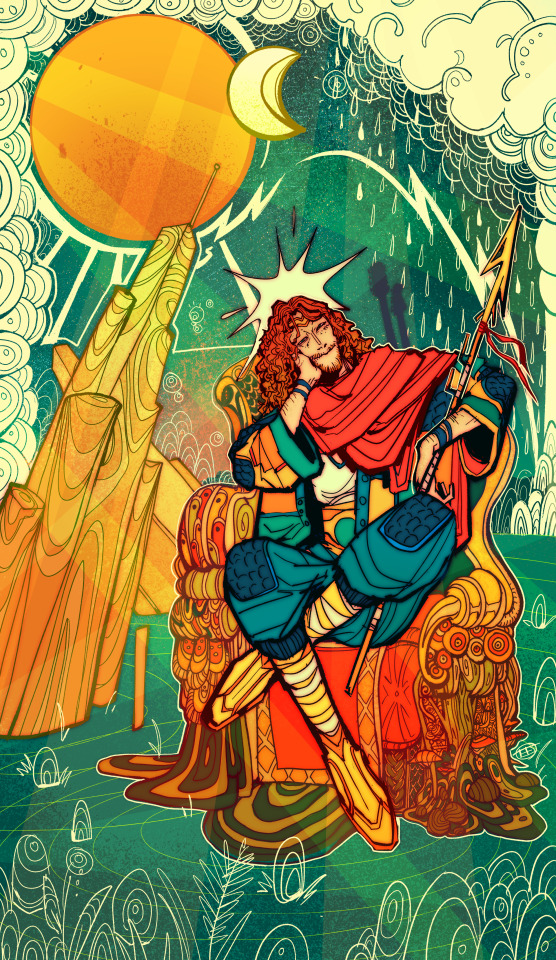
Been wanting to make more work based on Irish paganism and its stories (sort of a blending of jobs hahaha), so I started with an obvious option for me.
Lugh, master of many skills! The "many skills" bit comes in handy for work and an endless sea of special interests, for sure.
535 notes
·
View notes
Text
Sigils
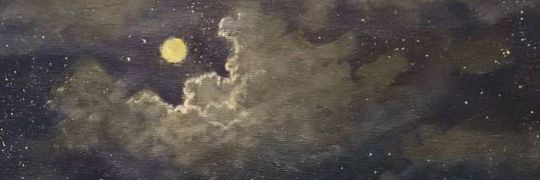
What is it?:
A sigil is a symbol for a magical or spiritual meaning.
Historically:
Sigils were used as a signature for an angel, demon, or spirit
Primarily 3 Types of Sigils:
Destructible: Destructible sigils are activated by being destroyed. This is usually done by writing your sigil on a piece of paper and then setting it on fire though you could also carve the sigil onto food and then consume it.
Temporary: Temporary sigils are made to last for a short while and must be renewed eventually. An example are sigils drawn on to the skin, carved into candles, etc.
Permanent: Permanent sigils are made to last and are meant to be active for a long period of time. Occasionally permanent sigils are recharged to keep the energy active. Sigils like these could be made into pottery as an art piece or you could write a sigil on a piece of paper to be placed behind a painting or under a piece of furniture.
How to Make a Sigil:
There is no one way to make a sigil. However, the most popular way is to write what you want to manifest down, remove the vowels, and then use the remaining letters to form a symbol. (There also online keys to help formulate sigils).
Sources:
Witchcraft 101
382 notes
·
View notes
Text

"Demeter Enraged"
Digital
11" x 17"
A sharp pain seized Demeter’s heart,
and she tore the headband out of her flowing, divine hair,
And threw a dark cloak over her shoulders.
Like a bird of prey she sped,
Over solid earth and fluid sea,
Searching.
Get prints here >> https://society6.com/art/demeter-enraged?utm_campaign=2574&utm_source=sharedlink&utm_medium=social&utm_content=ddp_from_artist_studio&fbclid=IwAR2Km5bZMiHQulvAXaiPMQavAbrCLi4ceQFNsDk-uAj3ueZm6T852HKNjAA
1K notes
·
View notes
Text
Hekate Correspondences According to Hekate Liminal Rites by Sorite d'Este
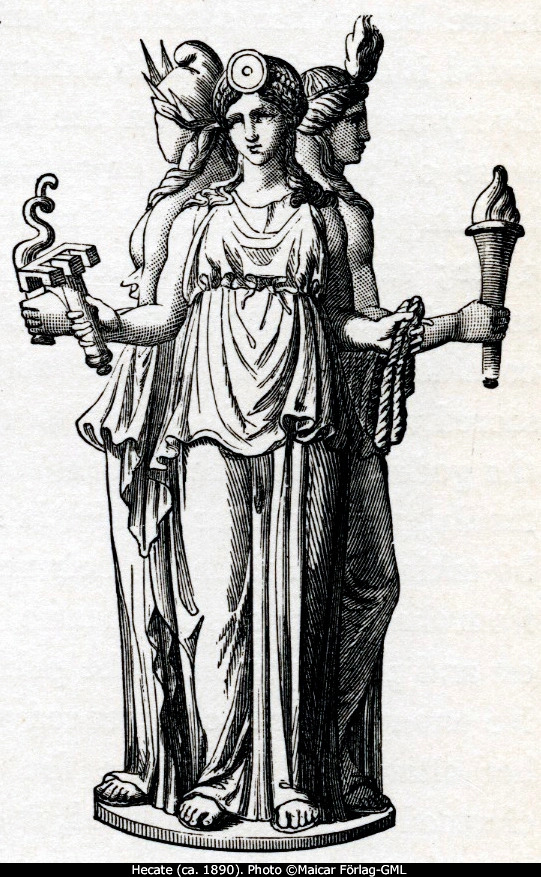
Goddess of: Crossroads, thresholds, boundaries, transitions, dreams and nightmares, oracles and divination, life and death, the restless dead, witchcraft and herbalism/poisons, protection, childbirth, the heavens, sea and earth.
Epithets: Chthonia (earthly one), Dadouchos (torch-bearer), Enodia ('of the wayside' or 'of the crossroad'), Kleidouchos (key-bearer), Kourotrophos (child's nurse), Phosphorus (light-bearer), Propolos (companion), Propylaia (the one before the gate), Soteira (savior), Triformis (three bodied), Trioditis (of the three ways), Brimo (angry/terrifying), Nexichthon (she who breaks open the earth), Prytania (invincible queen).
Symbols: Keys, torches, the moon, lunar crescent diadem, bronze/brass (her sacred metal), iron (particularly nails), bronze or golden sandals, virgin, garland/wreath, scorge, whips, sickles, swords, knives, wands, things done in threes, the strophalos, white, black, red, and saffron yellow.
Animal Associations: Lions, (black) dogs, horses, cows/bulls, hydras, snakes, bats, and dragons.
Plant Associations: Rue, laurel, cumin, sesame seeds, cornels, asphodel, maidenhair, rushes, galangal, verbena, sage, hedge-mustard, purple honeysuckle, cassidony, field basil. mandrake, hulwort, dittany, saffron, nose-smart, lion-foot, greenbriar, camomile, black poppy, alcua, all-heal, white hellebore, aconite, oak, ebony, garlic, and cypress.
Deities She's Worshiped With: Demeter and Kore (Eleusinian mysteries), Poseidon, and Hermes.
Deities She Absorbed: Brimo, Despoina, Enodia, Genetyllis, Kotys, Kratais, and Kourotrophos.
Deities She's Syncretised With: Artemis, Selene, Mene, Persephone, Physis, Bendis, Bona Dea, Diana, Ereschigal, and Isis.
Offerings: Dogs, goats, lizards (this can be something in their shape), incense and fragrances, resins like frankincense, myrrh, and storax, wafers and cakes, barley cakes, honey, vegetables, first fruits, flowers, fish like sprat and mullet, wine, milk, blood, oil, water, raw eggs, bread, cheese, and cheesecakes.
Types of Magic Historically Attributed to Her: Rejuvenation of the old, control over weather, necromancy/raising the dead, purification, love/binding/relationship destroying magic, invisibility/to move unseen, shapeshifting, control over animals, herbal/poison magic, and divination.
737 notes
·
View notes
Text
Devotional mixed media piece
Aphrodite - Μελαινις(Melainis) Black (of Night)
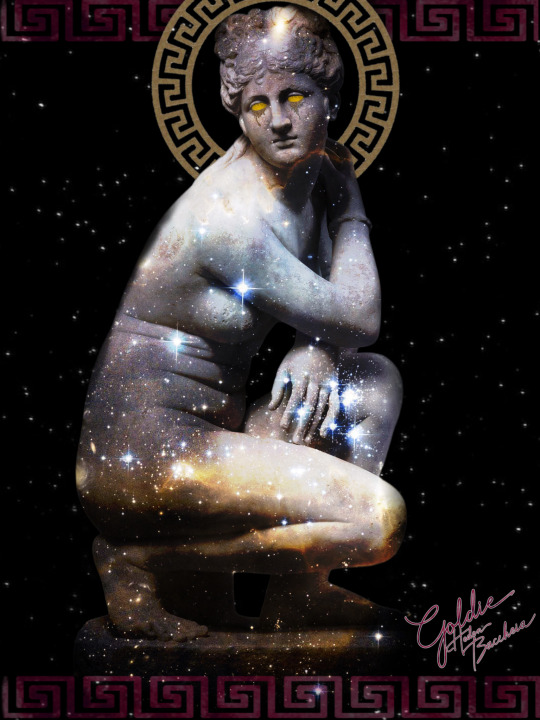
10 notes
·
View notes
Text
The main reason it's important to be at least somewhat literate in historical paganism and folk magic isn't so you can make your own practice exactly like it; it's to be able to recognize when someone is making historically inaccurate claims, because "asserting made-up shit about history as real fact" is a sign you're possibly looking at a cult and/or scam.
For the same reason, it's a good idea to be somewhat literate in pop culture media. Because being able to look at something a person is trying to pass off as Genuine Ancient Tradition or something and recognize that it's nothing like anything people actually believed or did back in Ye Olden Times but it sure as heck resembles something from a popular TV show or TTRPG is a valuable discernment skill.
1K notes
·
View notes
Text
it's okay if you have to re-read the myths or re-watch videos explaining them regularly because you forget what happens in them.
it's not something to be ashamed of.
732 notes
·
View notes
Note
Hey Alan!
Do you mind sharing your process/approach to making the "cheat sheets"? I've been thinking of doing something similar for Ancient Near Eastern deities if I ever have the ability in the future (probably without making amazing graphics like you though) like a profile or something. I don't know if I'll ever get energy but I thought I'd ask you before I forget, any guidance or tips would be lovely 💙
(feel free to publish, I know some don't publish non-anons)
Hi Michi!
That's wonderful! I'd love to see them! :)
The whole idea sort of began with me analysing my own practice one day and thinking "hey, I could've used something like this when I was starting out!"
I tried to think of some templates and things I'd like to include. The graphic format was just a matter of trial and error really, seeing what would work and look nice. Then, when it comes to information, I try to pick things that IMO are most 'basic' and 'essential' or could be thought of as most significant to the deity (major cult places, most famous epithets, symbols etc.), just things that could be both educational and useful in worship, especially for beginners, but I also like to include some interesting and perhaps lesser-known facts!
I think it's quite helpful to look back to the time when I was still new to all of this and just starting my research to see what I needed the most for worship and to get to know the deities better, so I take note of that. I narrowed it all down to things such as:
depictions of the deity
functions of the deity
closest family and companions
name and famous epithets
how and where they were worshipped
symbols and associations
iconic myths
offerings and potential devotional acts
basic prayers and hymns
[This might not apply to all deities, though, since when it comes to some of those things, the information about them could've been lost]
Some cheat sheets require more research, especially when it comes to minor deities. You really need to dig for some info. I try to look at ancient texts, epigrams, lexicons etc, some good research papers/books, and overall reliable ancient account-based sources as well as include some more modern popular UPGs/SPGs I've seen within the Hellenic polytheist community, e.g. Tarot associations (since plenty of us might use it in our practice as well). Theoi.com is definitely a lot of help. Sometimes I also try to translate some things with the little Greek I know if I feel like it's needed.
Depending on how easily accessible the information is and how much time I have, it could take up to a few days to make one cheat sheet. It's worth all the work, though, and the feedback I've received keeps me motivated! It's also quite satisfying and I can always learn a thing or two myself! I like to think of doing this as a sort of devotional act to the deity as well, that I get to do this not just for other people but for the deity, too, as a way to show my appreciation for them!
So, this is my approach! Hope it helps! 💜
50 notes
·
View notes
Text
Poseidon
Learn About:
Earthquakes
Sea creatures
Sea monsters from different traditions
Horses
The ocean/sea
Sailor culture
Your local coastal ecosystem
Pollution in bodies of water
Natural disasters and what causes them/how to help them
His Roman counterpart, Neptune
Water in general
Map-making/make your own map
Sailing knots
Sailor sayings
Boats/sailing
His genealogy/Myths
Water magick
Seagulls
Seas/Oceans/Bodies of Water
Collect ocean/sea/river/lake/pond water to offer Him/Use in spells
Go swimming
Take a lifeguard class/Swimming lessons
Sit by the water and meditate
Meditate to water sounds
Dip your feet in the water if you can’t fully emerge yourself
Go surfing/parasailing/jetskiing
Go fishing (If you keep any, offer the first one caught to Him)
Boat rides
Walk by the water
Go to the beach/lake/river
Float on your back in the water and vibe
Go canoeing/kayaking
Splash in puddles
Water
Take a cleansing shower/bath
Drink water
Encourage others to drink water (I always carry water bottles and hand them out as needed)
Perform water magick
Learn to scry with water
Keep your pet’s water bowl(s) clean!
Earthquakes/Hurricanes
Learn proper storm precautions
Learn what causes them
Pray to Him for safety for yourself/others
Participate in storm relief clean up
Donate to natural disaster relief
Miscellaneous
Learn CPR
Pick up beach litter
Make sandcastles
Make paper boats
Wear deep/sea blues/greens
Recycle your water bottles/use a reusable one
Offerings
Dedicate your water bottle to Him
Toy boats/boat imagery
Fish/sea creature imagery
Fishing equipment
Water
Bathing suits/swimming gear
Bull/horse/dolphin imagery
Wave/water representation
Rocks/sticks from by the water
Sand
Seagulls feathers (Collected and sanitized appropriately, of course)
Trident imagery
Blue/green crystals
Seaweed
317 notes
·
View notes
Text
Devotional activities for Hellenic pagans
Learn to pray and write in Greek, or at least download the duo lingo app and add Greek as a language you’d like to learn
Read the Greek Magical Papyri, Drawing Down the Moon, and the collection of texts called Gods and Heroes of the Ancient World, curated by Susan Deacy
Go op shopping and choose an item you are drawn towards to use in your practice
Research the use of stones and crystals in Ancient Greece - I am planning to make a post on this soon.
Research the use of herbs in Ancient Greece - I am also planning on making a post on this.
Research and make a traditional amulet
Write a prayer to the gods and burn it ceremoniously
Play a game or read/watch media related to the gods that is fun and relaxing - such as playing Hades or reading Circe by Madeline Miller. I realise these depictions of the Gods are flawed, but for many people it’s a fun way to connect with the gods. Just don’t take it too seriously.)
Read or watch a play by one of the ancient writers, such as Euripides’ Medea or the Bacchae.
Read a reputable translation of the Odyssey
Wear a symbol of your God/s
Reach out to other Hellenic pagans through the discord server https://discord.gg/MBvmV6FN
331 notes
·
View notes
Photo
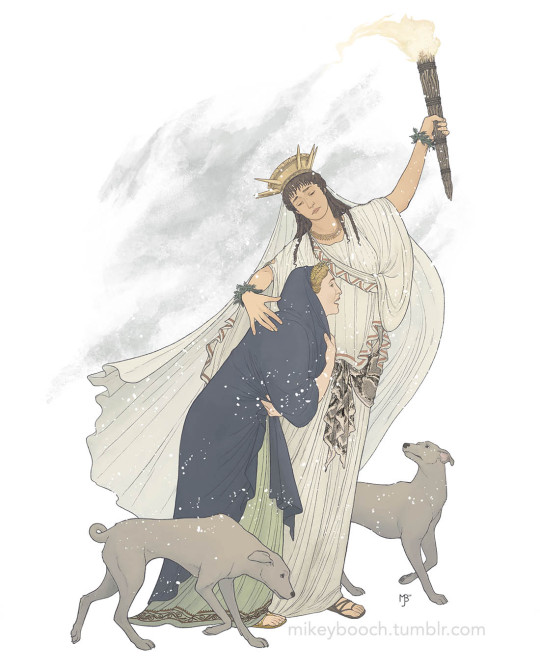
“…Hekate, with a torch in her hands, met Demeter, and spoke to her and told her news: ‘Queenly Demeter, bringer of seasons and giver of good gifts, what god of heaven or what mortal man has rapt away Persephone and pierced with sorrow your dear heart? For I heard her voice, yet saw not with my eyes who it was. But I tell you truly and shortly all I know.’
So, then, said Hekate. And the daughter of rich-haired Rhea answered her not, but sped swiftly with her, holding flaming torches in her hands.”
-Homeric Hymn to Demeter
7K notes
·
View notes
Photo

“…Hekate, with a torch in her hands, met Demeter, and spoke to her and told her news: ‘Queenly Demeter, bringer of seasons and giver of good gifts, what god of heaven or what mortal man has rapt away Persephone and pierced with sorrow your dear heart? For I heard her voice, yet saw not with my eyes who it was. But I tell you truly and shortly all I know.’
So, then, said Hekate. And the daughter of rich-haired Rhea answered her not, but sped swiftly with her, holding flaming torches in her hands.”
-Homeric Hymn to Demeter
7K notes
·
View notes
